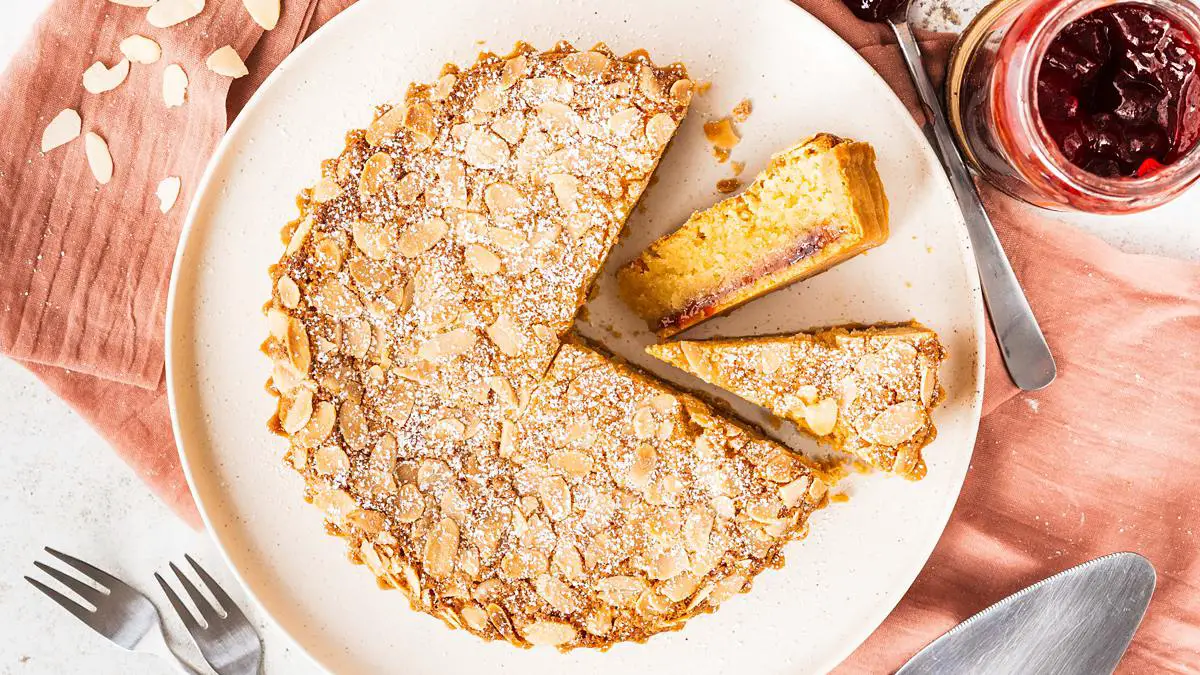Welcome back friends! Today I’m sharing the inimitable Bakewell Tart, a very British bake indeed! Comprising a crisp shortcrust shell, a delightful jam layer and an irresistible frangipane all topped with flaked almonds. Yum!
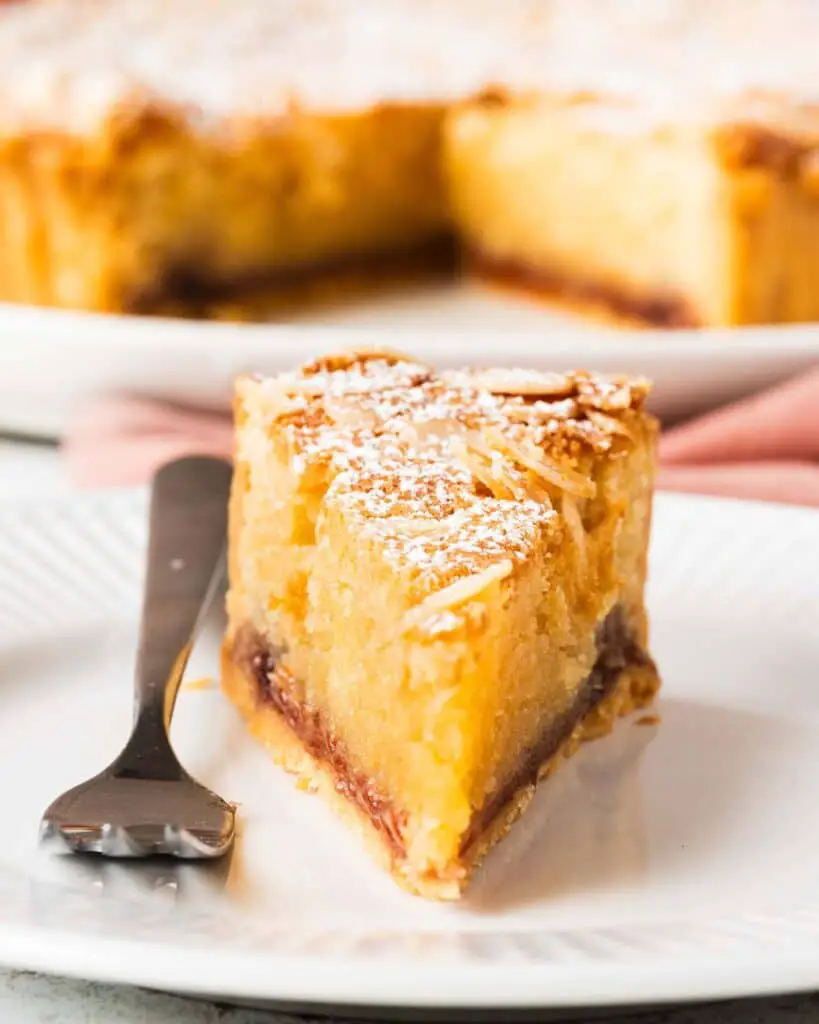
What is a Bakewell tart?
A traditional Bakewell tart is a very British bake! It consists of a shortcrust pastry shell filled with layers of jam and almond frangipane before being topped with flaked almond slices.
When was the Bakewell tart invented?
Although the exact date of the invention of Bakewell tarts is unknown, it is thought to be in the early 1800s, some sources suggesting it was around 1820.
It is said Mrs Greaves, who was the landlady of a local inn, asked her cook to make a jam tart. Instead of incorporating the almond paste into the pastry, the cook spread the mixture over the jam instead. This created something more akin to an egg custard with a jam layer.
Funnily, the cook’s mistake ended up being so popular and successful that the recipe stuck!
The first printed recipe for Bakewell tart was called a Bakewell Pudding and it appeared in Eliza Acton’s 1845 cookbook, Modern Cookery for Private Families.
Is a Bakewell tart from Bakewell?
Yes! The flavour combination originated in a little town in the north of the UK called Bakewell, which is what the infamous tart is named after.
Layers for a Bakewell tart
Bakewell tart recipes all have the same basic layers. They are:
- Pastry shell. A shortcrust pastry shell carries the fillings to make this signature British bake,
- Jam layer. Traditionally, raspberry jam is the choice, but it is also common for strawberry or even cherry jam to be used too.
- Frangipane. A paste made with ground almonds. It is layered over the jam in the pastry shell before baking to firm up.
- Flaked almonds. An optional add on, gives extra texture to the Bakewell tart easy.
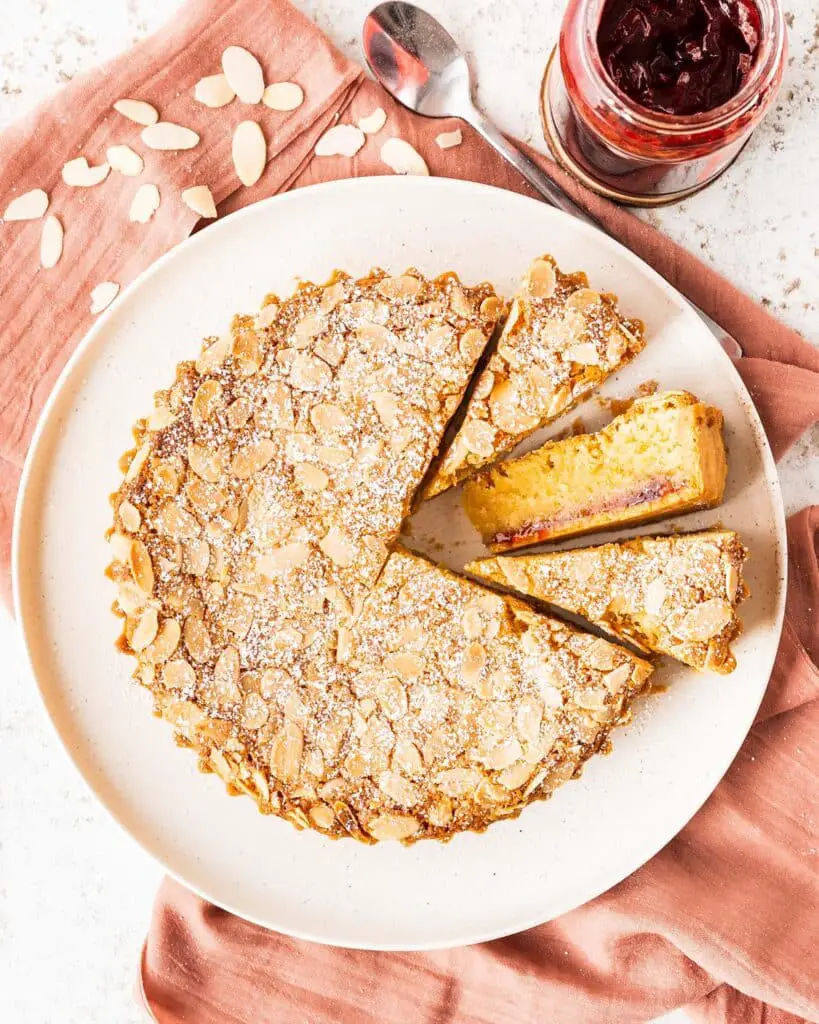
What ingredients do I need to make this Bakewell tart recipe?
- Flour: I use plain flour for my pastry when making this easy Bakewell tarts recipe as I do not want any rise in it.
- Icing/powdered sugar: for sweetness in the pastry and to dust the top of the baked best Bakewell tart recipe.
- Butter: I like to use unsalted butter so I can control how much salt is in the bake. For best results, use cold butter when making the pastry and room temperature butter for the filling in this easy Bakewell tart recipe.
- Eggs: yolks only in the pastry add richness and flavour, and whole eggs in the frangipane filling.
- Ice cold water: make sure to use cold water when making pastry. You want to keep the dough as cold as possible throughout the whole process.
- Golden caster sugar: for sweetness in the frangipane filling.
- Ground almonds: gives the frangipane its texture and almond flavour in this Bakewell tarts recipes.
- Almond extract: a little additional almond flavour is always heavenly, in my world!
- Jam/conserve: one of the essentials in this bake. I always use raspberry jam to make this recipe Bakewell tarts, but you could use cherry in a pinch too if you wish.
- Flaked almonds: scattered over the top of the tart, gives a little extra texture and delicious almond flavour to this recipe Bakewell tart.
Recommended tools to make a Bakewell tart
- Digital kitchen scales*: I always recommend using digital kitchen scales to weigh ingredients out over using a volume based measuring system, as cups. Weighing out the ingredients is much more accurate than measuring by volume, and will ensure better results in the cookies, so I would definitely take the plunge if you have not already.
- Measuring spoons*: for measuring smaller quantities such as tablespoons (tbsp) and teaspoons (tsp), a set of dedicated measuring spoons is a must! These are far more accurate than everyday eating spoons, and are really easy to get hold of too.
- Food processor*: a quick way to make the pastry. If you do not have a food processor, you can simply use your fingers to rub the ingredients together too.
- Sieve*: useful to remove lumps from the dry ingredients before blending together when making the pastry.
- Rolling pin*: for rolling out the pastry. If you do not have a rolling pin, get creative! A tall glass or even a wine bottle works well!
- Mixing bowl*: to make the frangipane filling in before spreading into the pastry case ahead of baking the best recipe for Bakewell tart.
- Handheld electric mixer*: helps you get a lovely smooth frangipane with ease for this Bakewell tart best recipe.
- Loose-bottomed tart tin*: makes it a lot easier to remove the tart from the tin without breaking it. I like using one with a fluted edge as I think it looks so very pretty. However even a loose bottomed cake tin (without the fluted edge) will work well too.
How to make Bakewell tart
Whilst there are a few more time-taking processes, making this easy Bakewell tart recipe could not be more straightforward! First, make the pastry and let it chill for about half hour. Then, roll out the dough and line the tart tin before chilling again. During the second chill, prepare the frangipane. Bake and seal the pastry before layering in the jam and frangipane, topping with flaked almonds. Bake for the final time before allowing to cool completely. Dust lightly with icing sugar before serving. Enjoy!

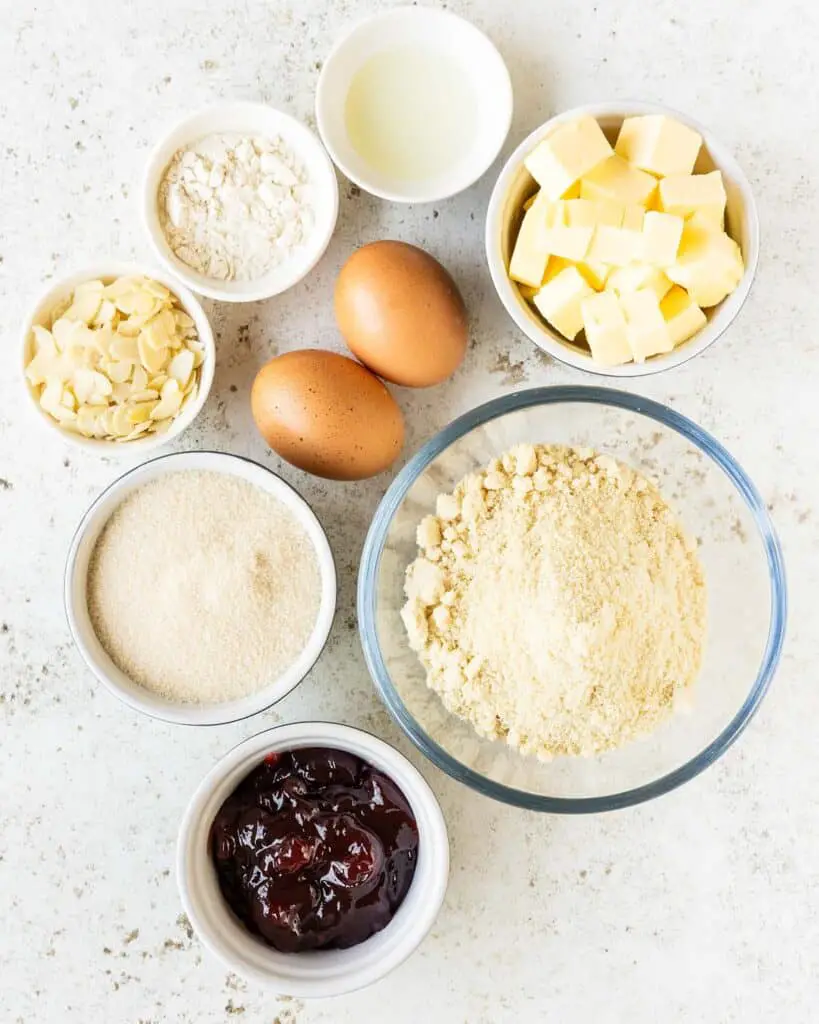
For the pastry
Step 1: First make the pastry. In a food processor or a large mixing bowl, mix together the flour and sugar. Add in the cubes of cold butter and cut or blend in until the mixture resembles fine breadcrumbs. Ensure no large chunks of unblended butter remain or it will speckle the pastry when it is rolled out. Tip in the egg yolks and blend again until just combined. Add in the ice water a little at a time until the pastry comes together in clumps.
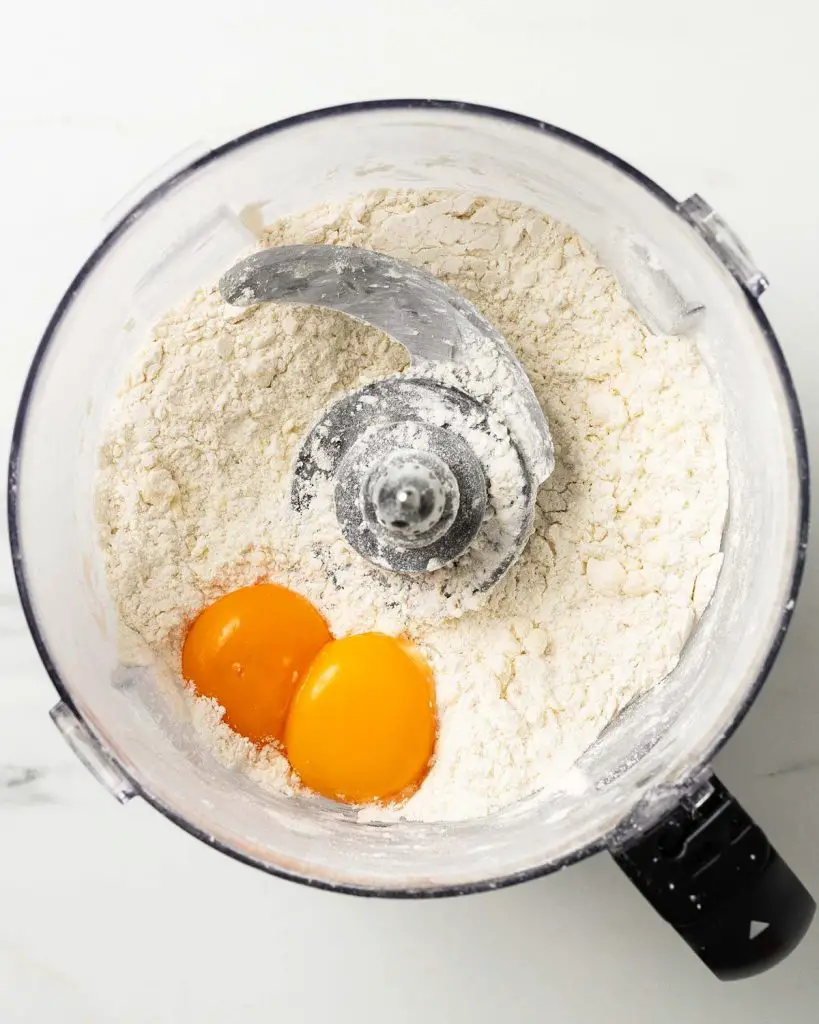

Step 2: Tip the dough out onto a clean work surface and gather it together. Squeeze to bring it together, but try to avoid kneading and working it too much or the pastry will be tough. Divide the pastry dough into two equal parts and flatten into discs. Wrap each disc tightly in cling film then pop in the fridge to chill for at least 30 minutes. At this point, you can freeze the dough for another day, if you wish.
Step 3: Once the dough is made and has chilled, roll out the chilled pastry to a circle about 2″ larger than an 8″ tart tin. Fold it carefully over the rolling pin and lift it into the tin. Ease the pastry into the edges. Do not stretch the pastry to make it fit. After lining the tin with pastry, gently fold the overhang of pastry over the tip of the tin. Using the rolling pin, roll over the top of the tin to cut off excess pastry. Prick several holes in the bottom of the pastry, then pop in the fridge to chill for a further 30 minutes.
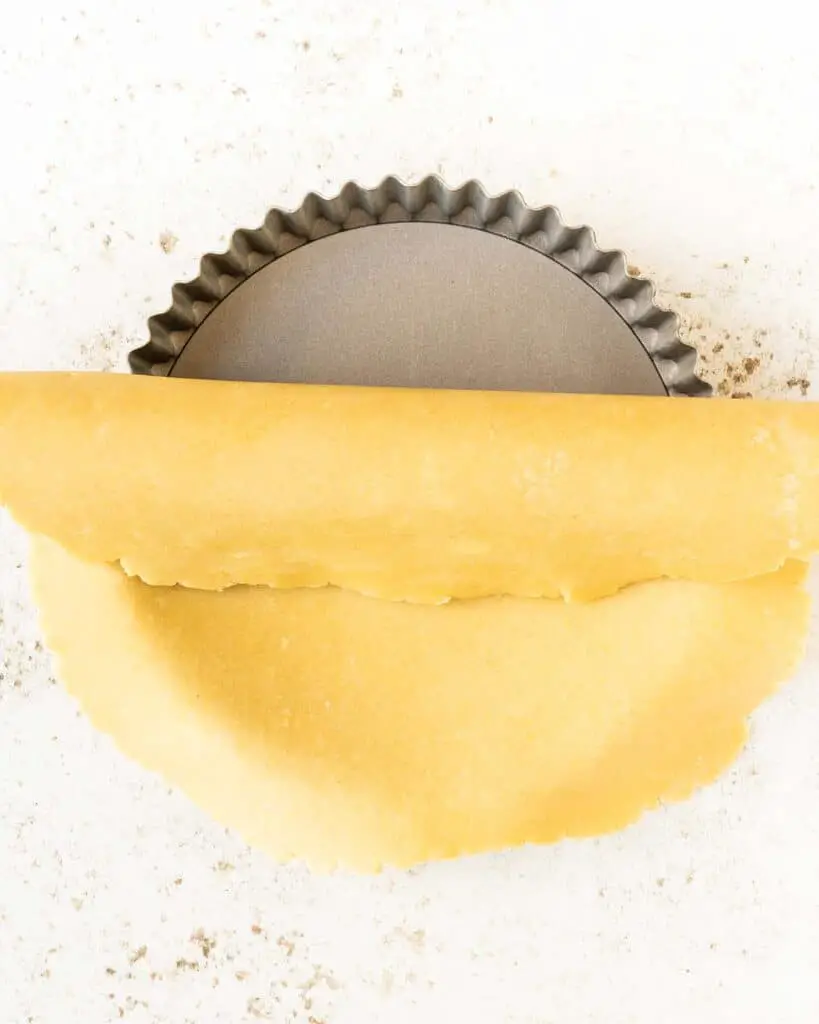


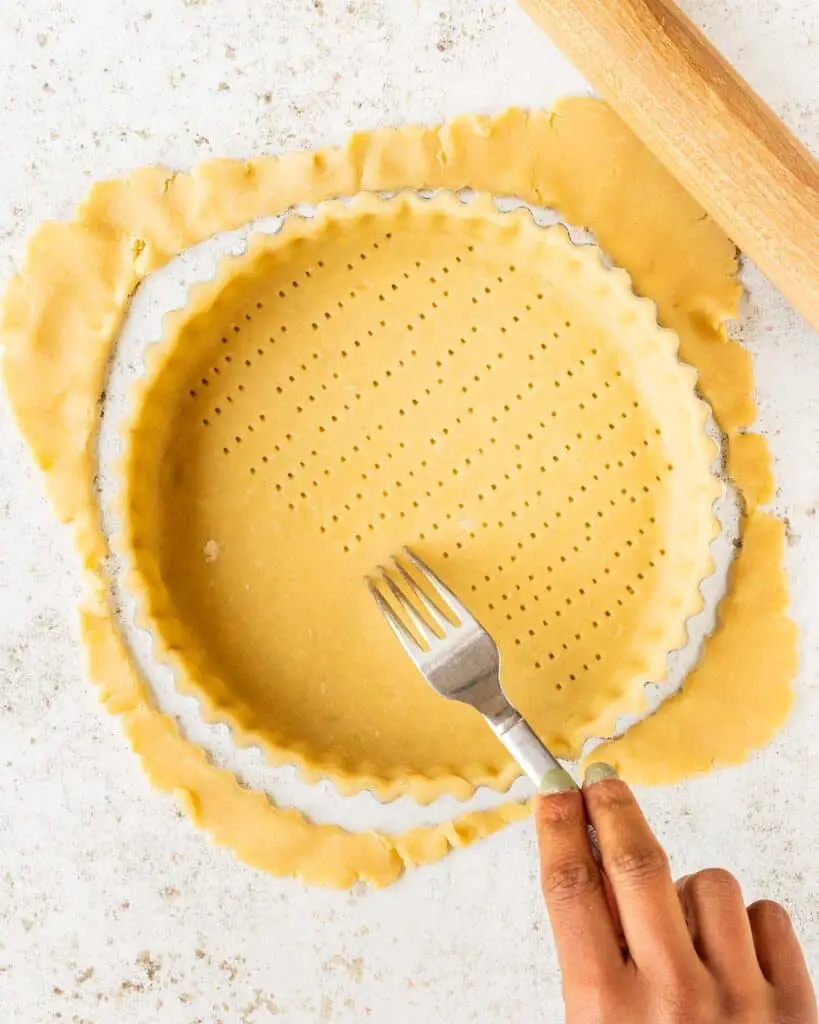
For the frangipane
Step 1: Whilst the dough is getting its second chill, make the frangipane. In a mixing bowl, soften the butter, then add in sugar, ground almonds, egg and almond essence. Beat all the ingredients together until completely combined. The mixture will be thick, this is perfect. Transfer to a small piping bag, for ease if using, then set it aside.
Step 2: In a small separate bowl, place the jam and stir to loosen, adding a little water if needed. This is an optional step, but can make it a little easier to spread the jam into the pastry case if needed.
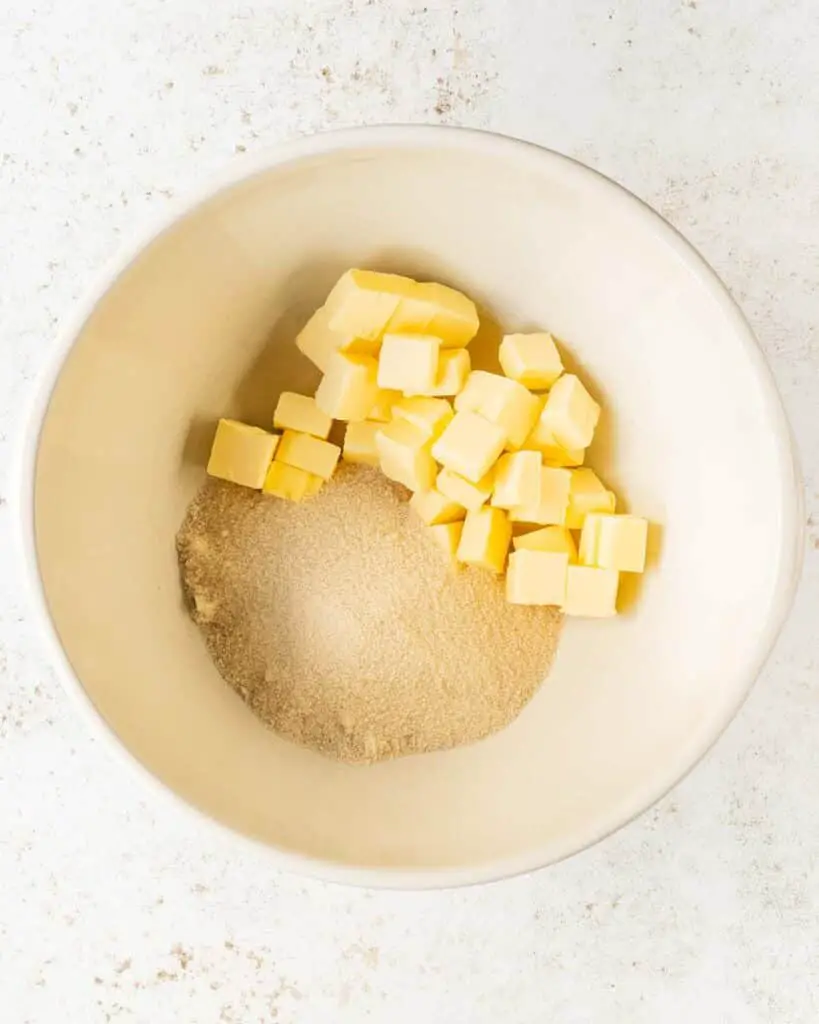
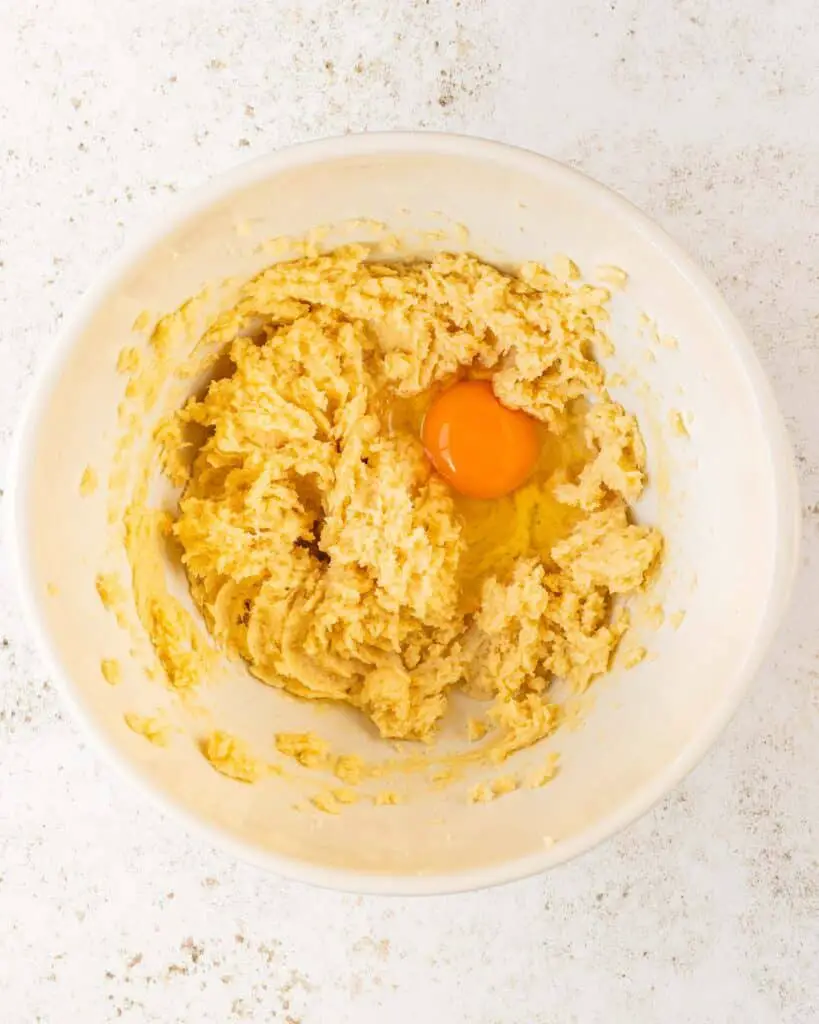
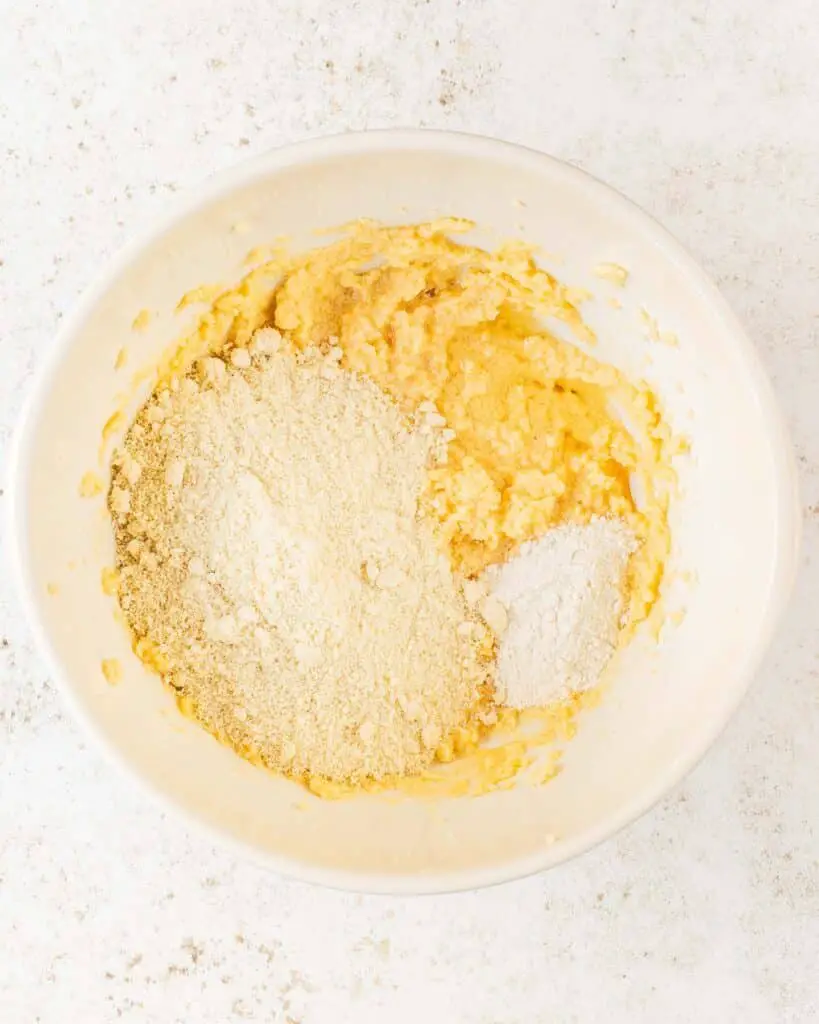
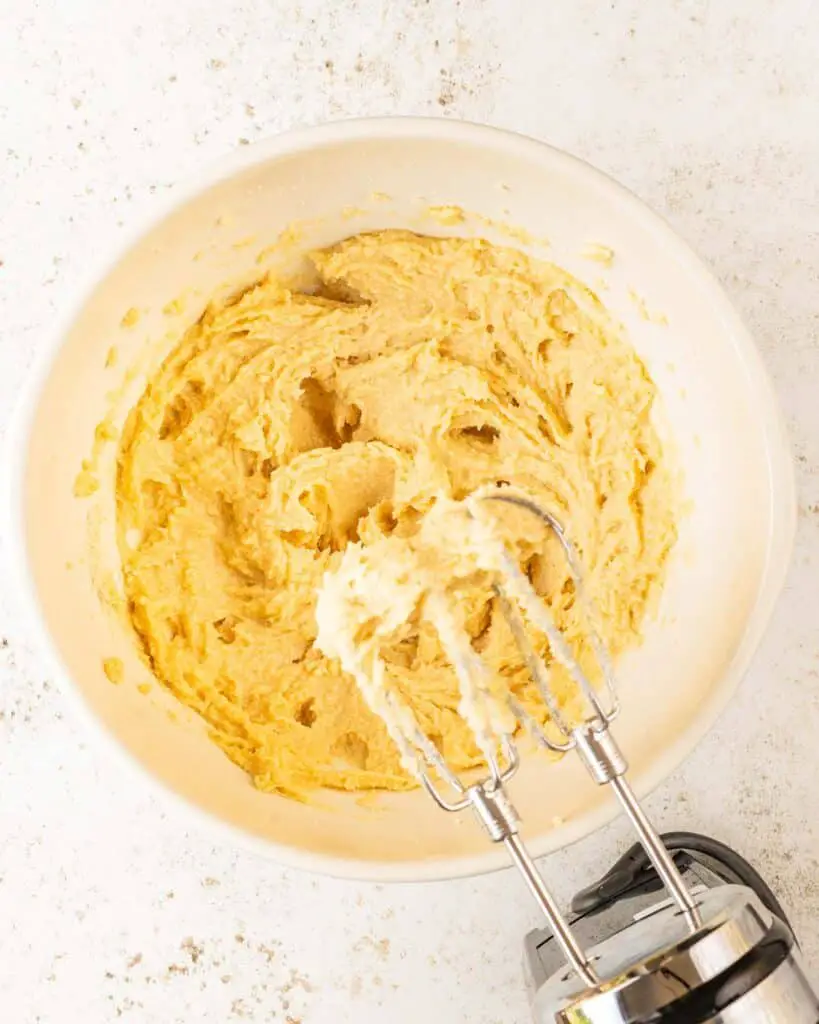
To bring the Bakewell tart together
Step 1: Time to get baking! First, preheat the oven to 160C/320F. Prepare a piece of parchment paper large enough to fit inside the pastry shell with some overhang. Scrunch it up, then open it again, so that it is malleable. Remove the tin from the fridge and press the paper into the shell, easing into the corners. Fill with baking beans (see notes), then once the oven has reached temperature pop the tin in the oven. Bake blind for 20 minutes, then remove the paper and baking beans and bake a further 10 minutes until golden and biscuity. Remove from the oven and place on a wire rack.
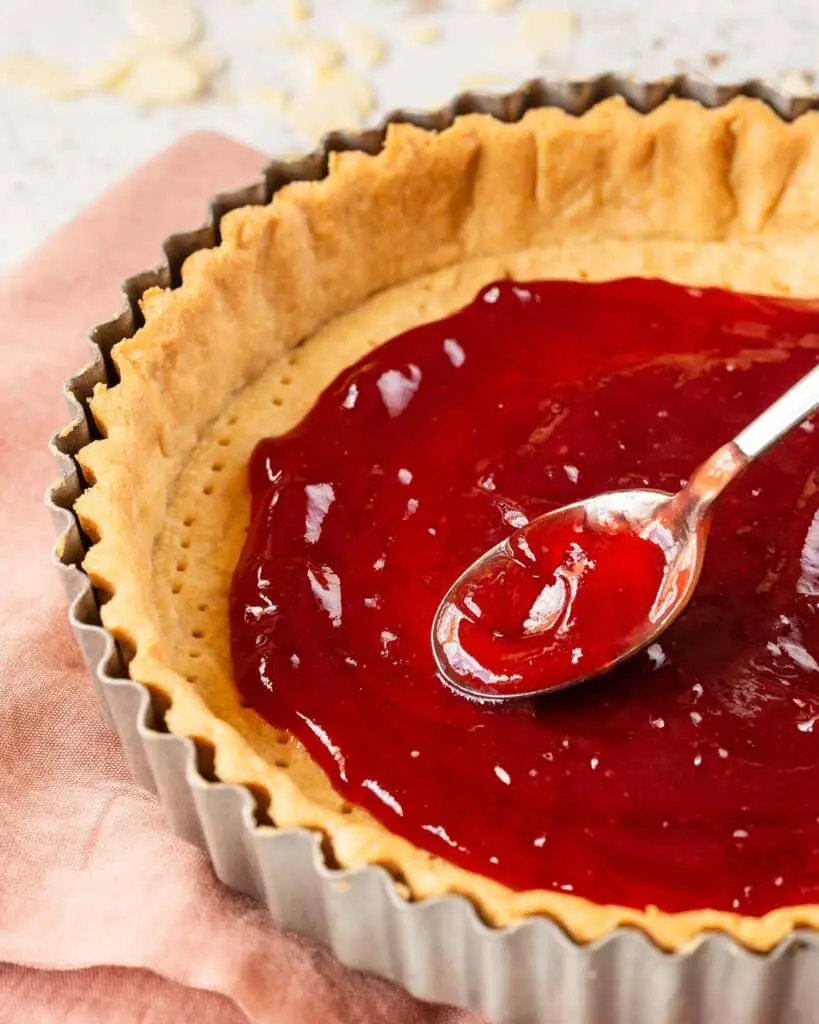
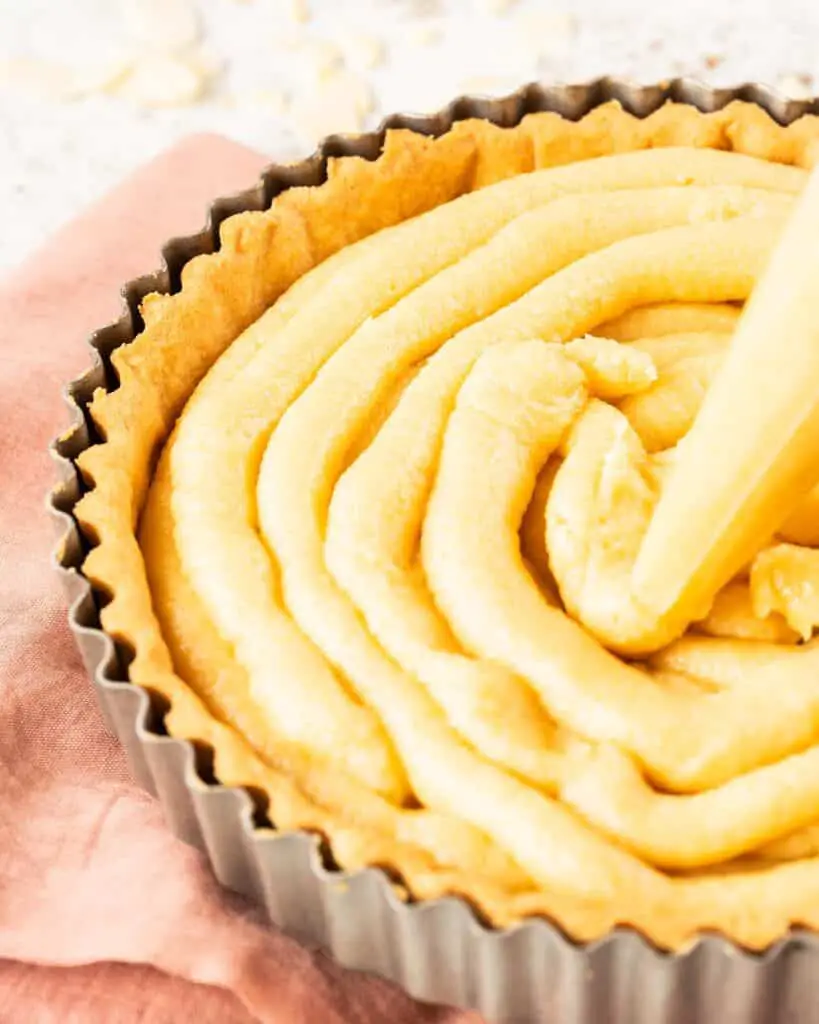
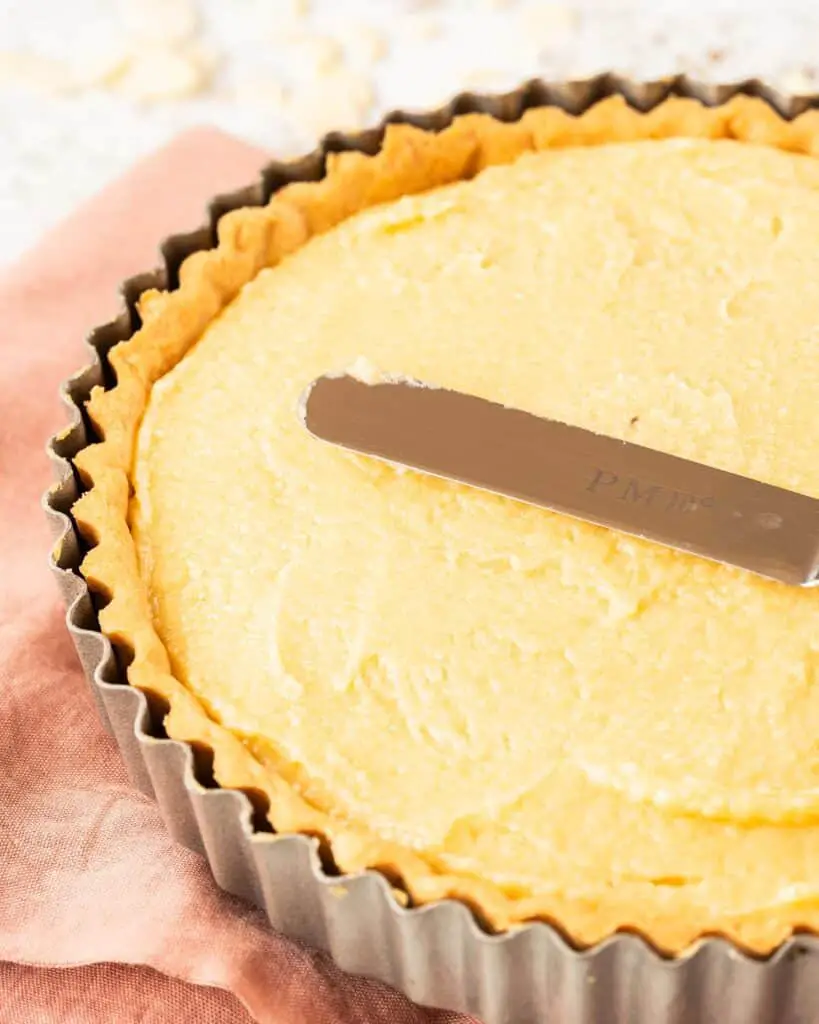
Step 2: Place the jam at the bottom of the pastry shell, spreading almost to the edges. Pipe on the frangipane, filling it near the top, but no higher than the pastry edge. Using an offset spatula or a knife, gently ease the frangipane all the way to the edge of the pastry case, sealing the jam at the bottom. This is an important detail to avoid your jam bubbling up and bursting through the frangipane, making for a messy tart. Sprinkle the top of the tart with flaked almonds.
Step 3: Bake the bakewell tart for 45-50 minutes until the pastry edge is golden and the filling is only JUST set. Remove from the oven and leave in the tin to cool completely.
Step 4: The tart is good to be served as it, but I like to dust it with a little icing (powdered) sugar to finish the top. Enjoy!
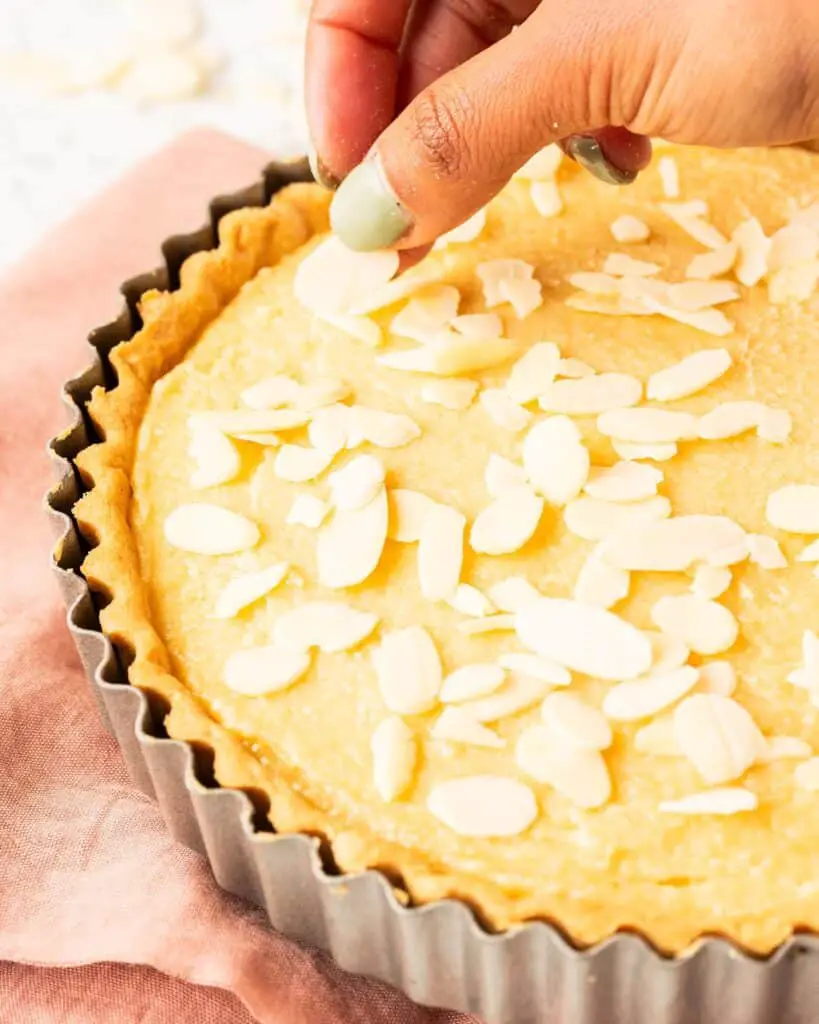
Frequently asked questions about pastry
Pastry is one of the bakes that has a few factors that could go wrong, and bit of information worth knowing. I have tried to answer as many commonly asked questions as I can, but please do use the comments below if you have any I have not answered for you here.
Why is my shortcrust pastry fragile and crumbly?
This is likely because the dough is too dry and needs a little more liquid adding to it. Break it up into crumbs again and gently mix through enough liquid until the dough naturally forms clumps before bringing back together, chilling and then rolling again.
Why is my shortcrust pastry tough?
If the pastry is tough or gummy, it is likely that too much gluten has developed. The most likely cause of this is overworking (over mixing or over kneading) the dough.
Why my shortcrust pastry sticking to my work surface/rolling pin?
The moisture in the dough makes it stick to surfaces. A very simple solution is to lightly dust the work surface and rolling pin with a little extra flour (not too much, you do not want to dry out your pastry!) and try rolling it out again. As you roll, keep turning the pastry through 90º so it doesn’t stick to the work surface. If you find it is not rolling out too easily, gently lift the pastry over your rolling pin and lightly dust the surface under it with flour before rolling again. This should allow you to get beautiful thin pastry!
Do I need to blind bake my pastry?
In this recipe, you will definitely need to blind bake (and then baked after blind baking too!) the pastry. This is required to seal the pastry since the filling is fairly moist before baking. It helps to ensure you do not end up with a soggy pastry base.
How do I know when my pastry is baked?
The pastry is baked, after the blind bake and the second “browning” bake, when it is pale golden in colour and biscuity looking. If it looks a little doughy or wet, leave it to bake for a few minutes longer.
Are Bakewell tarts suitable for vegetarians?
Bakewell tarts are definitely suitable for vegetarians. However, they do contain eggs so would not be suitable for those avoiding eggs as part of a vegetarian diet.

How long does Bakewell tart last? How do I store it?
This tart should be stored in an airtight container and will be fine kept at room temperature for 2-3 days.
Can I freeze Bakewell tart?
Yes absolutely! You can freeze just the pastry or the tart once made. Read on for both ways.
How to freeze pastry
Once you have made the pastry, wrap it tightly in cling film and freeze for up to a month. Thaw in the refrigerator overnight before using.
How to freeze a Bakewell tart
First, allow it to cool completely, then place and store in an airtight container. It can be frozen for up to two months this way. To thaw, remove from the freezer and from the container. Leave the tart to come to room temperature on a cooling rack once unwrapped (I leave it overnight) before enjoying.
What to serve Bakewell tart with
I think this Bakewell tart recipe is perfect served just as a simple slice. However, if you wish you could also serve it with a bit of pouring cream or a dollop of freshly whipped cream. Or why not try warming it up a little and serving with a scoop of ice cream? So many delicious options!

Tips and tricks for the best Bakewell tart recipe
- As an exception to most baking, make sure to use ingredients as cold as possible when making pastry: so cubed butter straight from the fridge and ice cold water. Keeping pastry cold helps avoid overworking the gluten and keep it relaxed to avoid shrinkage during baking.
- Handle the pastry dough as little as possible throughout making. This is especially important when bringing it together, as overworking the gluten will lead to tough pastry.
- When placing the pastry into the tin, try not to stretch the dough to make it fit. Stretching the dough may look fine once in the tin, but doing so will result in the dough shrinking back to its pre-stretched size and shape during baking, spoiling the look of the tart.
- Chill the pastry again once rolled and shaped into the tin. Chilling the pastry a second time allows the gluten to relax again, helping it hold its shape better and not be tough once baked.
- Spread the jam layer evenly over the base of the pastry, but not all the way to the edge. It will spread slightly over baking, so will look like it reaches the edges once baked. Doing this is one part of helping to prevent the jam bubbling up and over the frangipane, spoiling the look of the tart.
- Piping the frangipane over the jam helps to get it spread out more evenly without disturbing the jam underneath too much, so I would definitely recommend piping if you can!
- Once you have put the frangipane layer over the jam layer, use a knife or off set spatula to gently level it and ease it all the way to the edges of the pastry case. Sealing the jam is important so it does not bubble over and make a mess of the top of the Bakewell tart.
- Swap out the raspberry jam for cherry or strawberry if you prefer, or that’s what you have in. All will work!

Troubleshooting
If you have any other questions about this easy Bakewell tart recipe, please use the comments below to ask away and I will do my best to help. And if you do make this recipe for Bakewell tart, please take a moment to leave a rating and review below. I would love to know how you enjoy making it and following along, plus it really helps others looking for a similar recipe too. You could even post a picture on Instagram and tag me when you share it with the world, you know I love seeing all your bakes!
More delicious recipes for you to enjoy
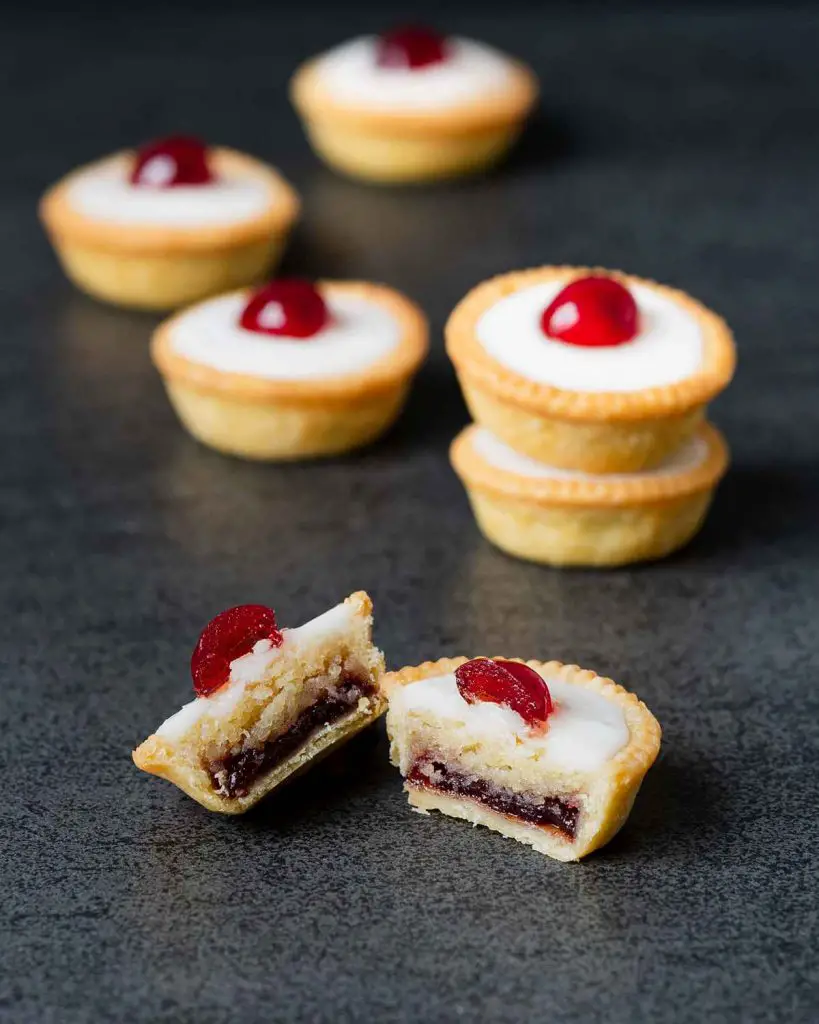
Mini cherry Bakewell tartlets: This mini Bakewell tarts recipe is the only one you will ever need for the perfect adorable bake. Beautiful buttery pastry, rich cherry jam, scrumptious almond frangipane. All topped with a layer of icing and, of course, the obligatory cherry on top!

Lemon tart: A classic dessert renowned for its bright flavour and simple but elegant presentation. The zesty lemon flavour in a creamy custard filling served in buttery pastry can never fail to impress. It is no wonder a lemon tart has remained a firm favourite across the world!
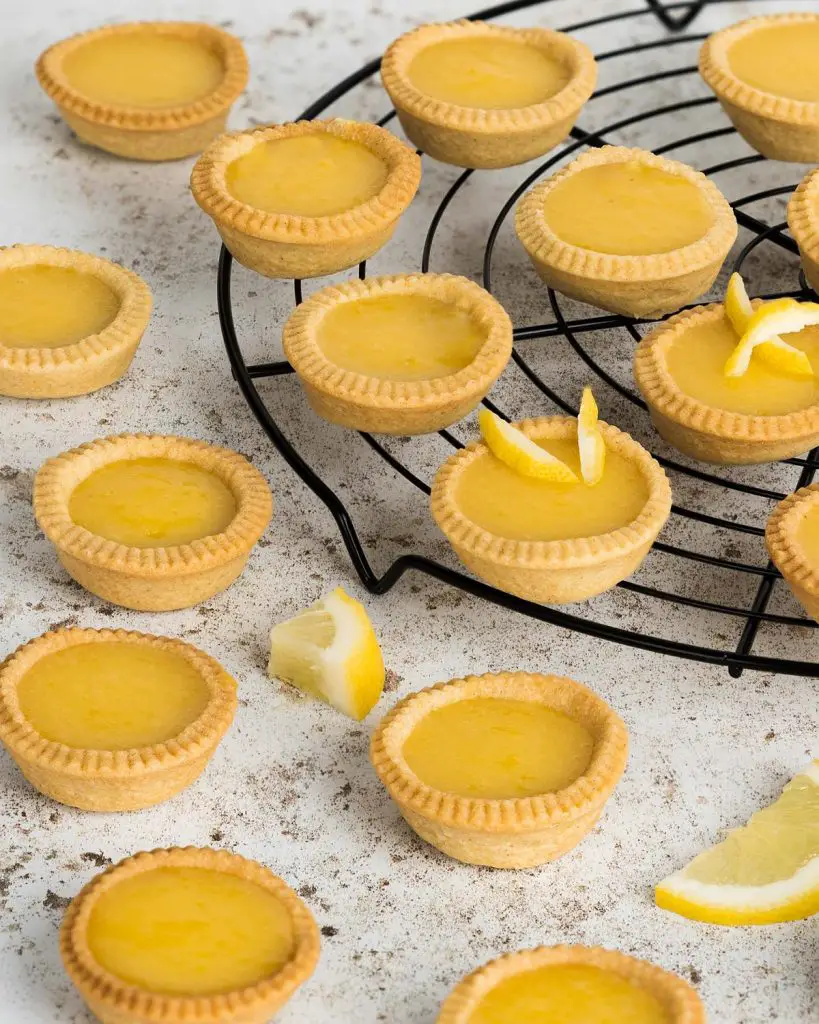
Lemon curd tarts: A delightfully joyful bake, these lemon curd tarts are sure to make you smile! A beautiful buttery mini shortcrust pastry shell filled to the brim with a bright and zingy lemon curd. The whole thing just melts in your mouth and is pure sunshine in a mouthful!
And that’s all from me for today! Hope you enjoy making this beauty as much as I enjoy sharing with you. Happy baking, my friends! x
Recommended equipment I used *
| Digital kitchen scales | Measuring spoons |
| Food processor | Sieve |
| Rolling pin | Mixing bowl |
| Handheld electric mixer | Loose-bottomed tart tin |


